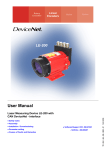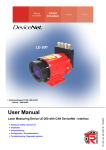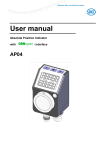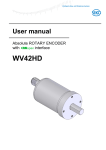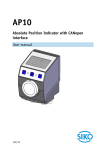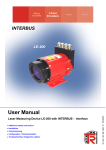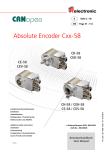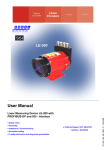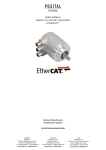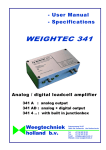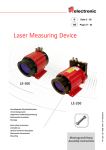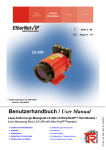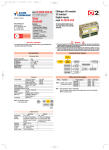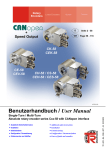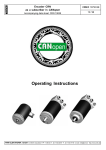Download User Manual - TR Electronic
Transcript
LE-200 User Manual ● Safety notes ● Assembly ● Installation / Commissioning ● Parameter setting ● Causes of Faults and Remedies ● Software/Support CD: 490-01001 - Soft-No.: 490-00408 TR - ELE - BA - GB - 0010 - 03 18.12.2007 Laser Measuring Device LE-200 with CANopen - interface TR-Electronic GmbH D-78647 Trossingen Eglishalde 6 Tel.: (0049) 07425/228-0 Fax: (0049) 07425/228-33 E-mail: [email protected] http://www.tr-electronic.de Copyright protection This Manual, including the illustrations contained therein, is subject to copyright protection. Use of this Manual by third parties in contravention of copyright regulations is forbidden. Reproduction, translation as well as electronic and photographic archiving and modification require the written content of the manufacturer. Offenders will be liable for damages. Subject to amendments Any technical changes that serve the purpose of technical progress, reserved. Document information Release date/Rev. date: Document rev. no.: File name: Author: 18.12.2007 TR - ELE - BA - GB - 0010 - 03 TR-ELE-BA-GB-0010-03.DOC MÜJ Font styles Italic or bold font styles are used for the title of a document or are used for highlighting. Courier font displays text, which is visible on the display or screen and software menu selections. ″< > ″ indicates keys on your computer keyboard (such as <RETURN>). Trademarks CANopen is a registered trademark of CAN in Automation e.V. © TR-Electronic GmbH 2007, All Rights Reserved Page 2 of 48 Printed in the Federal Republic of Germany TR - ELE - BA - GB - 0010 - 03 18.12.2007 Revision History Revision History i Note The cover of this document shows the current revision status and the corresponding date. Since each individual page has its own revision status and date in the footer, there may be different revision statuses within the document. Documents that are in the appendix have their own revision history. Document created: 24.07.2003 Revision Date Expansion of the function for the error output, object 2005 • Speed-check, configurable via TRWinProg - New Object: 2007, Resolution - Revision of the warning label in chapter "Intended purpose" - Modification of the Laser Standard DIN EN 60825-1 - Warning bit “Plausibility measured value” - Additional reflector foils, chap. Accessories - Max. measuring range 240 m 11.12.2003 18.12.2007 © TR-Electronic GmbH 2007, All Rights Reserved Printed in the Federal Republic of Germany 18.12.2007 19.09.2003 TR - ELE - BA - GB - 0010 - 03 Page 3 of 48 Table of Contents Table of Contents Revision History ...............................................................................................................................3 Table of Contents .............................................................................................................................4 1 Safety ..............................................................................................................................................6 1.1 General risk potential.......................................................................................................6 1.2 Safety information............................................................................................................6 1.2.1 Hints on installation..........................................................................................7 1.2.1.1 General interference suppression measures ..................................8 1.3 Intended purpose.............................................................................................................9 1.4 Authorized operators .......................................................................................................11 1.5 Safety measures at the installation site...........................................................................11 2 General Description ......................................................................................................................12 3 Transportation / Storage...............................................................................................................13 4 Assembly instructions ..................................................................................................................14 4.1 Aligning of the laser light spot to the reflector / foil inclination.........................................14 4.2 Parallel operation of laser linear paths ............................................................................16 5 Commissioning / Installation .......................................................................................................17 5.1 Electrical connection........................................................................................................17 5.1.1 Supply voltage .................................................................................................17 5.1.2 CANopen .........................................................................................................17 5.1.2.1 Bus termination ................................................................................18 5.1.2.2 Identifier (Node-ID) ..........................................................................18 5.1.2.3 Baud rate .........................................................................................18 5.1.2.4 Length of the bus line.......................................................................18 5.1.3 Switching input / Switching output ...................................................................19 5.1.4 RS485 - programming interface ......................................................................19 5.1.5 Switching on the supply voltage ......................................................................19 5.1.6 Wiring examples ..............................................................................................20 5.2 CANopen interface ..........................................................................................................21 5.2.1 Bus status ........................................................................................................21 5.2.2 EDS-file............................................................................................................21 5.2.3 The communication profile ..............................................................................22 5.2.3.1 1st Transmit Process Data Object (asynchronous)..........................22 5.2.3.2 2nd Transmit Process Data Object (synchronous) ...........................22 5.2.4 Communication specific standard objects .......................................................23 5.2.4.1 Object 1000h: Device Type .............................................................24 5.2.4.2 Object 1001h: Error Register ...........................................................24 5.2.4.3 Object 1002h: Manufacturer Status Register ..................................24 5.2.4.4 Object 1003h: Pre-defined Error Field.............................................25 5.2.4.5 Object 1004h: Number of PDOs supported.....................................26 5.2.4.6 Object 1005h: COB-ID SYNC message ..........................................26 5.2.4.7 Object 1008h: Manufacturer Device Name .....................................27 5.2.4.8 Object 1009h: Manufacturer Hardware Version ..............................27 5.2.4.9 Object 100Ah: Manufacturer Software Version ...............................27 5.2.4.10 Object 100Bh: Node-ID..................................................................27 5.2.4.11 Object 100Ch: Guard-Time............................................................27 5.2.4.12 Object 100Dh: Life Time Factor.....................................................28 © TR-Electronic GmbH 2007, All Rights Reserved Page 4 of 48 Printed in the Federal Republic of Germany TR - ELE - BA - GB - 0010 - 03 18.12.2007 Table of Contents 5.2.4.13 Object 100Eh: Node Guarding Identifier........................................28 5.2.4.14 Object 1010h: Store Parameters ...................................................28 6 Configuration / Parameter setting via the CANopen master ....................................................30 6.1 Standardized encoder profile area ..................................................................................30 6.1.1 Object 2000 - Clear Preset ..............................................................................31 6.1.2 Object 2001 - Output value in case of an error ...............................................31 6.1.3 Object 2003 - Function external input..............................................................31 6.1.4 Object 2004 - Automatic error acknowledgement .............................................32 6.1.5 Object 2005 - Function error output.................................................................32 6.1.6 Object 2006 - Switching functions ...................................................................32 6.1.7 Object 2007 - Resolution .................................................................................33 6.1.8 Object 6000h - Operating parameters .............................................................33 6.1.9 Object 6003h - Preset value ............................................................................33 6.1.10 Object 6004h - Position value........................................................................34 6.1.11 Object 6005h – Measuring step.....................................................................34 6.1.12 Object 6200h – Cyclic timer...........................................................................34 6.1.13 Laser diagnostics...........................................................................................35 6.1.13.1 Object 6500h - Operating status....................................................35 6.1.13.2 Object 6501h – Measuring step.....................................................35 6.1.13.3 Object 6503h - Alarms ...................................................................35 6.1.13.4 Object 6504h - Supported alarms..................................................36 6.1.13.5 Object 6505h - Warnings ...............................................................36 6.1.13.6 Object 6506h - Supported warnings ..............................................37 6.1.13.7 Object 6507h – Software version...................................................37 6.1.13.8 Object 6508h - Operating time.......................................................37 6.1.13.9 Object 6509h - Offset value ...........................................................37 6.1.13.10 Object 650Ah - Manufacturer offset value ...................................37 6.1.13.11 Object 650Bh - Serial number .....................................................37 7 Emergency Message .....................................................................................................................38 8 Transmitting of the laser position value .....................................................................................39 8.1 Read/Write Service Data Object .....................................................................................40 8.1.1 Read SDO: ......................................................................................................40 8.1.2 Write SDO:.......................................................................................................41 9 Causes of Faults and Remedies ..................................................................................................42 10 Maintenance.................................................................................................................................43 10.1 General Maintenance Information .................................................................................43 10.2 Repair, Maintenance .....................................................................................................43 11 Appendix ......................................................................................................................................44 11.1 Specifications ................................................................................................................44 11.1.1 Electrical ratings ............................................................................................44 11.1.2 Environmental conditions ..............................................................................45 11.2 Accessories ...................................................................................................................45 11.3 References ....................................................................................................................46 11.4 Definitions and Abbreviations ........................................................................................47 Pin Assignment.........................................................................................TR-ELE-TI-GB-0010 Pin Assignment, CiA DR 303-1 conform ............................................... TR-ELE-TI-DGB-0011 Drawings Dimensioned drawing ............................................................................ 04-K2200-002 © TR-Electronic GmbH 2007, All Rights Reserved Printed in the Federal Republic of Germany 18.12.2007 TR - ELE - BA - GB - 0010 - 03 Page 5 of 48 Safety 1 Safety 1.1 General risk potential The Laser Measuring Device LE-200 CANopen cannot be operated independently, but is installed as part of an overall system usually consisting of several interacting components. For this reason, the laser measuring device is not equipped directly with a protective device. Warning The corresponding measures must be taken in order to avoid person and property damages! However, in the event of an error via the error register "Object 1001h: Error Register", page 24 a generally occurred error is displayed by setting the bit 5. Via the "Object 1003h: Pre-defined Error Field", page 25 the error occurred generally is specified and the cause described in detail. Via the "Emergency Message", page 38 the Error Register/Error Field can be read. It is therefore essential to integrate the error messages into your own safety system via the evaluation software (e.g. a PLC). All persons responsible for the assembly, start-up and operation of the device must • be suitably qualified • adhere strictly to this operating manual. Your safety and the safety of your equipment depends on this! 1.2 Safety information This operating manual contains information which must be observed in the interests of your own personal safety and that of your equipment. The safety hints are emphasized by a warning triangle and classified according to the degree of danger as follows: Warning means that failure to take the relevant safety precautions can lead to serious damage to property or injuries. i Note refers to important information and features of the product, plus tips on its application. © TR-Electronic GmbH 2007, All Rights Reserved Page 6 of 48 Printed in the Federal Republic of Germany TR - ELE - BA - GB - 0010 - 03 18.12.2007 Safety 1.2.1 Hints on installation Since the Laser Measuring Device is normally used as part of a larger system, these hints are merely intended as a guide for integrating the device safely into its environment. Warning • During the operation of the Laser Measuring Device it isn't allowed to interrupt the laser beam. If it comes nevertheless to an interruption, at the restart of the automatic operation mode first the validity (plausibility) of the measured value has to be checked. • Precautionary measures must be taken to allow an interrupted program to be properly resumed following a voltage drop or failure. Dangerous operating conditions must not be permitted to arise even for short periods. If necessary, an "EMERGENCY STOP" must be forced. • EMERGENCY STOP devices according to EN 60204/IEC 204 (VDE 0113) must remain operational in all operating modes of the programmable controller. The release of the EMERGENCY STOP devices must not trigger an uncontrolled or undefined reactivation of the equipment. • The safety and accident prevention regulations applicable to the specific application must be observed. • In the case of permanently installed plants or systems without an all-pole mains switch and/or fuses, one of these devices must be installed accordingly and the equipment connected to a PE conductor. • In the case of 24 V supplies, make sure the extra-low voltage is reliably disconnected. Only use power supply units manufactured to the standards IEC 364 - 4 - 41 / HD 384.04.41 (VDE 0100 Part 410). • Fluctuations or deviations of the supply voltage from the nominal value must not exceed the tolerance limits stated in the specifications, otherwise operational failures and dangerous states in the electrical assemblies cannot be ruled out. • Connecting and signal wires must be installed in such a way as to prevent the automation functions from being hampered by inductive and capacitive interference. • The units of the automation system and their operating elements must be installed in such a way as to ensure adequate protection against accidental actuation. • In order to prevent a wire or strand breakage on the signal side from causing undefined states in the programmable controller, suitable hardware and software safety precautions must be taken with regard to the I/O interface. © TR-Electronic GmbH 2007, All Rights Reserved Printed in the Federal Republic of Germany 18.12.2007 TR - ELE - BA - GB - 0010 - 03 Page 7 of 48 Safety 1.2.1.1 General interference suppression measures • Lay the (shielded) connecting cable to the device at a sufficient distance or in a separate room from any power cables which are subject to interference. Otherwise the data transmission of the measured value can be interfered. • To ensure reliable data transmission, use fully shielded cables and make sure they are well earthed. For differential data transfer (RS422, RS485 etc.), twisted-pair wires must be used in addition. • Use a minimum cable cross-section of 0.22 mm2 for data transfer purposes. • Use a minimum earthing cable (machine base) cross-section of 10 mm2 in order to avoid equipotential currents across the shield. Make sure the resistance of the earthing cable is much lower than that of the shield. • Avoid crossing cables where possible. If unavoidable, only cross them at right-angles. • Ensure continuous wiring of the shield and a large contact area on special shield clampings or cable screw glands, see Figure 1 point (A) and (B). B ERR OK RUN A 1 20 X1 DIP-Switch ON 0 2 2 7 OFF Figure 1: Connection cap with cable screw glands and shield clampings Shield connection via cable screw glands: 1. Screw the cable screw gland into the housing. 2. Dismount the compression nut (1) and the terminal holder (2). 3. Push the compression nut (1) and the terminal holder (2) over the cable. 4. Strip the cable; push back the braiding around the terminal holder (2) such that the braiding goes over the inner O-ring (3) and does not lie over the cylindrical section or the torsional bars. 5. Insert the terminal holder (2) into the intermediate gland (4) such that the torsional bars fit into the intended lengthwise grooves in the intermediate gland (4). 6. Screw the compression nut (1) to the intermediate gland (4). © TR-Electronic GmbH 2007, All Rights Reserved Page 8 of 48 Element 1 Compression nut Element 2 Terminal holder Element 3 inner O-ring Element 4 Intermediate gland Printed in the Federal Republic of Germany TR - ELE - BA - GB - 0010 - 03 18.12.2007 Safety 1.3 Intended purpose The measuring system is used for recording linear movements and processing the measured data for a downstream control system with a CANopen Field Bus interface according to ISO/DIS 11898. The laser measuring device with CANopen protocol supports the device profile for Encoder CiA Draft standard 406, version 2.0. Particularly the measuring system is designed for the use of distance measurements for the detection of the position and positioning of: ! ! ! ! High-bay storage devices and lifting gears Crane systems Side-tracking skates and truck storage vehicles Transfer machines Warning Switch off the voltage supply before carrying out wiring work or opening and closing electrical connections! Short-circuits, voltage peaks, etc. can cause operating failures and uncontrolled operating states, as well as serious personal injuries and damage to property. Check all electrical connections before switching on the system! Incorrectly wired connections can cause operating failures, while wrong connections can lead to serious personal injuries and damage to property. Mechanical or electrical modifications to the measuring systems are prohibited for safety reasons! In particular the following uses are forbidden operation in areas where interruption of the laser beam, e.g. by covering the laser lens opening, can lead to equipment damage or injury to personnel in environments, in which strong rain, snow, fog, steams or direct insolations etc. can influence the laser beam intensity negatively operation in rooms with explosive atmospheres operation for medical purposes With use-purposes larger 125m measuring length, a special reflector must to be used! (see chapter "Accessories", page 45) © TR-Electronic GmbH 2007, All Rights Reserved Printed in the Federal Republic of Germany 18.12.2007 TR - ELE - BA - GB - 0010 - 03 Page 9 of 48 Safety Warning Laser Light Do not stare into the beam Laser Class 2 P max = 1 mW, λ = 670 nm DIN EN 60825-1: 2003-10 Complies with 21 CFR 1040.10 and 1040.11 except for deviations pursuant to laser notice No. 50, July 2001 • In the case of Class 2 laser devices, the eye is not endangered if the exposure of the laser radiation is very short (up to 0.25 s) and accidental. For this reason, devices of this class can be used without additional protective measures, provided for the application it is not necessary to look into the laser beam deliberately for longer periods, i.e. 0.25 s, or to look repeatedly into the laser beam itself or the specular reflected beam. The existence of the blinking reflex for the protection of the eyes may not be assumed. Therefore the eyes should be closed consciously, or the head should be turned away immediately! • The device must be installed in such a way that the exposure of persons to the laser beam can only happen accidentally. • The laser beam may only extend as far as is necessary for the range measurement. The beam must be limited at the end of the useful range by a diffusely reflecting target area in such a way as to minimize the danger from direct or diffuse reflection. For this purpose, you should use the TR-Electronic reflecting foil supplied with the device. • The area outside the operating range where the unshielded laser beam falls should be limited as far as possible and should remain out of bounds, particularly in the area above and below eye level. • Observe the legal and local regulations applicable to the operation of laser units. i Note The start-up, operating and programming instructions contained in this manual are mandatory. © TR-Electronic GmbH 2007, All Rights Reserved Page 10 of 48 Printed in the Federal Republic of Germany TR - ELE - BA - GB - 0010 - 03 18.12.2007 Safety 1.4 Authorized operators The start-up and operation of this device may only be performed by qualified personnel. For the purposes of this manual, the term "qualified personnel" refers to persons who are authorized to operate, earth and label equipment, systems and power circuits according to recognized safety standards. 1.5 Safety measures at the installation site Warning Do not perform any welding work once the device is connected and switched on! Variations in potential can destroy the device or restrict its operation. Do not touch plug contacts with your hands! Static charges may destroy electronic components of the device. Do not connect unused inputs (see pin assignment)! Observe the voltage supply range: Standard device: 18-27 V DC (± 5 %) Device with heating: 24 V DC (± 5 %) Clean lens opening of the laser and the reflecting foil regularly! (see chapter "Maintenance", page 43) i Note Make sure that the environment of the installation site is protected against corrosive media (acids, etc.) © TR-Electronic GmbH 2007, All Rights Reserved Printed in the Federal Republic of Germany 18.12.2007 TR - ELE - BA - GB - 0010 - 03 Page 11 of 48 General Description 2 General Description The laser measuring devices of the series LE are optical sensors, with which larger distances can be measured without contact and serviceable for controller. The measuring system consists of the real measuring device with laser light source, receiving optics, electronic evaluation and data interface as well as a reflector. The device sends out a modulated light beam which is reflected by the reflector. From the phase difference of the sent and received light beam the distance is measured 1000 times per second. Thus the LE is suitable also directly for the position feedback in controller loops. According to the requirements the laser distance measuring devices of the series LE-200 CANopen are configured either directly over the CAN-bus or with the PCprogramming software "TRWinProg". Principle Receiver signal ϕ Transmitter signal ϕ = Phase displacement Reflecting foil d = Distance d = f(ϕ) Measuring start 0,2m Measuring end Display range max. 240m (Special Device) © TR-Electronic GmbH 2007, All Rights Reserved Page 12 of 48 Measuring range 125m Printed in the Federal Republic of Germany TR - ELE - BA - GB - 0010 - 03 18.12.2007 Transportation / Storage 3 Transportation / Storage Transport instructions Do not drop the device or expose it to shocks or vibrations! Device contains an optical system with glass elements. Only use the original packaging! The wrong packaging material can cause damage to the device during transportation. Storage Storage temperature : -20 to +75°C Store in dry conditions. © TR-Electronic GmbH 2007, All Rights Reserved Printed in the Federal Republic of Germany 18.12.2007 TR - ELE - BA - GB - 0010 - 03 Page 13 of 48 Assembly instructions 4 Assembly instructions The adjustment of the laser measuring device in the vertical plain is carried out via four studs (A) in the mounting plate. The adjustment in the horizontal plane can be made by four hexagon bolts (B). It has to be taken into account that the screw diameter is approx. 1-2 mm smaller than the through bore of the mounting plate. Exact dimensional properties are on the dimensional drawing in the rear part of the document. B A Figure 2: Mechanical adjustment possibilities 4.1 Aligning of the laser light spot to the reflector / foil inclination i The measuring device or reflector is attached to the moving object and the reflector/sensor to the fixed remote station in such a way that the reflector always remains within the visual field of the sensor. This can be done using the light spot of the laser diode, which is still clearly visible on the reflecting foil even at long distance. When aligning the laser measuring device, the user may need to take measures to ensure that it can be mechanically adjusted. The size of the reflecting foil must be such that the light spot cannot be displaced from the reflector by vibrations. Since with an increasing distance the light spot gets larger and larger, the edge areas of the foil also have to be avoided. The device comes with a reflecting foil measuring 20 x 20 [cm], but other sizes can be ordered on request. Note Reflecting foils by other manufacturers should not be used under any circumstances, as all the information in the "Specifications" chapter refers to the foil already supplied with the device. © TR-Electronic GmbH 2007, All Rights Reserved Page 14 of 48 Printed in the Federal Republic of Germany TR - ELE - BA - GB - 0010 - 03 18.12.2007 Assembly instructions Procedure: • Figure 3: Detection of the surface reflectivity: At first attaching the reflector foil flatly and drive plant on minimal distance Laser – Foil. Centering paper (C) in front of the laser optics so, that the laser beam can unhinderedly emerge by an approx. 2 cm hole. Now, the interfering signal (B) should get visible on the paper (C). To the better location of the interfering signal (B) the reflector foil can be moved also a little. Here it is valid: angle of incidence = angle of reflection • Figure 4: Transmitting away the surface reflectivity: Rotate the reflector foil in the Y- or in the Z-axis so, that the interference signal (B) always is outside the laser lens. Nevertheless keeping the inclination of the reflector foil as low as possible to minimize measuring errors caused by misalignments in the procedure movement. For example, if the light spot drifts on the reflector foil around, small differences arise as a result of the oblique position. Fix reflector foil (A) real wanted signal, is always thrown back 180° independently of the reflector inclination Figure 3: Detection of the surface reflectivity (B) Surface reflectivity (interference signal) (C) Paper with an approx. 2 cm large hole in the center Figure 4: Transmitting away the surface reflectivity © TR-Electronic GmbH 2007, All Rights Reserved Printed in the Federal Republic of Germany 18.12.2007 TR - ELE - BA - GB - 0010 - 03 Page 15 of 48 Assembly instructions 4.2 Parallel operation of laser linear paths It has to be taken care in the parallel operation of laser linear paths that a minimum distance of 1 m is kept. The reflector foil inclination must be made in such a way that the surface reflectivity (see arrows) points not into the other laser linear path. The alignment is carried out as described in chapter 4 / 4.1. Figure 5: Minimum distance in parallel operation © TR-Electronic GmbH 2007, All Rights Reserved Page 16 of 48 Printed in the Federal Republic of Germany TR - ELE - BA - GB - 0010 - 03 18.12.2007 Commissioning / Installation 5 Commissioning / Installation 5.1 Electrical connection i Note At the realization of the electrical connection the references in chapter 1.2.1, starting from page 7 must be considered. CiA DR 303-1 conformal pin assignment see “TR-ELE-TI-DGB-0011” In order to be able to carry out the connection, the connection cap must be removed from the laser first. For this the screws (A) are loosened and the cap (B) is removed away from the laser. ERR OK RUN B A 1 A 20 X1 DIP-Switch ON 2 0 2 7 OFF 5.1.1 Supply voltage Pin 7 0V, GND Pin 8 Standard: 18 – 27 V DC Device with heating: 24 V DC (±5%) 1 2 3 4 5 6 7 8 9 10 11 12 13 14 15 16 17 18 19 20 5.1.2 CANopen Pin 15 GNDI (reference potential CAN_L / CAN_H) Pin 16 Shield (internal RC-element onto case) Pin 17 CAN_H Pin 18 CAN_H 1 2 3 4 5 6 7 8 9 10 11 12 13 14 15 16 17 18 19 20 Pin 19 CAN_L Pin 20 CAN_L © TR-Electronic GmbH 2007, All Rights Reserved Printed in the Federal Republic of Germany 18.12.2007 TR - ELE - BA - GB - 0010 - 03 Page 17 of 48 Commissioning / Installation 5.1.2.1 Bus termination For the communication a defined no-signal level must be guaranteed on the CAN bus. To this both line ends have to be terminated with terminating resistors. In the laser measuring device is not provided an add-on connection of the terminating resistor. Therefore, if the laser measuring device is the last slave in the CAN bus line, the termination must be made manually with a terminating resistor of 121 ohms between the CAN_H and CAN_L lines. 5.1.2.2 Identifier (Node-ID) The identifier (laser address) 1 – 64 is adjusted via the DIL-switches 1-6: DIL-1 = ID 20, DIL-6 = ID 25 The Node-ID is the adjusted hardware number by the DIL-switches 1-6 + 1. That means: all 6 switches off = 0, Node-ID = 1 (see also "Object 100Bh: Node-ID", page 27) Note: The adjusted address may be assigned only once in the CANopen bus. 1 2 3 4 5 6 7 8 9 10 11 12 13 14 15 16 17 18 19 20 1 2 DIP-Switch ON 0 2 7 OFF 5.1.2.3 Baud rate The baud rate is adjusted via the DILswitches 7-8: 1 2 3 4 5 6 7 8 9 10 11 12 13 14 15 16 17 18 19 20 DIP-7 DIP-8 Baud rate OFF OFF 20 kbps ON OFF 125 kbps OFF ON 500 kbps ON ON 1000 kbps 1 2 DIP-Switch ON 0 2 7 OFF 5.1.2.4 Length of the bus line The max. bus line length is dependent on the adjusted baud rate: Baud rate 20 kbps 125 kbps 500 kbps 1000 kbps Line length [m] up to 2500 up to 500 up to 100 up to 25 © TR-Electronic GmbH 2007, All Rights Reserved Page 18 of 48 Printed in the Federal Republic of Germany TR - ELE - BA - GB - 0010 - 03 18.12.2007 Commissioning / Installation 5.1.3 Switching input / Switching output The programming of the switching input /switching output is carried out either directly via the bus, or via the PC software "TRWinProg". Functions of the switching input: - Preset - Switch off laser diode - Failure quit Functions of the switching output: - Temperature- , - Intensity- , - Hardware-Fail-Output or - every fail - Speed-check - Plausibility measured value - Switching output position Pin 1 GND, reference potential pin 2 Pin 2 Switching output Pin 3 Switching input 1 2 3 4 5 6 7 8 9 10 11 12 13 14 15 16 17 18 19 20 5.1.4 RS485 - programming interface The RS485 programming interface was developed mainly only as service interface for the technician. Primarily therefore the programming possibilities via the CANopen should be used. Via the PC software "TRWinProg" and a PC adapter the connection to the laser measuring device is established. More informations see page 20 or in the TRWinProg software manual. Pin 9 RS485– 1 2 3 4 5 6 7 8 9 10 11 12 13 14 15 16 17 18 19 20 Pin 10 RS485+ 5.1.5 Switching on the supply voltage After the connection, baud rate and Node-ID-setting has been carried out, the supply voltage can be switched on. After power on and finishing the initialization, the laser goes to the Pre-operational state and waits for command. If the laser detects an internal error, an emergency message with the error code will be transmitted (see chapter "Emergency Message", page 38). © TR-Electronic GmbH 2007, All Rights Reserved Printed in the Federal Republic of Germany 18.12.2007 TR - ELE - BA - GB - 0010 - 03 Page 19 of 48 Commissioning / Installation 5.1.6 Wiring examples * Shield connection, see chapter 1.2.1.1 page 8. CiA DR 303-1 conformal pin assignment see “TR-ELE-TI-DGB-0011” CAN_H CAN_L GNDI Shield US 0V CANopen connection X1 7 8 * 15 16 17 18 19 20 LE-200 0V Supply Voltage GNDI Shield (internal RC-element onto case) CAN_H CAN_H CAN_L CAN_L RS485-connection with parameter setting via "TRWinProg" © TR-Electronic GmbH 2007, All Rights Reserved Page 20 of 48 Printed in the Federal Republic of Germany TR - ELE - BA - GB - 0010 - 03 18.12.2007 Commissioning / Installation 5.2 CANopen interface The CAN-Bus-Interface is defined by the international norm ISO/DIS 11898 and specifies the two lowest layers of the ISO/DIS CAN Reference Model. The CAN-BUS-Interface with the BUS-Driver PCA82C251 is galvanic isolated of the laser electronic and becomes the power over internal DC/DC-converter. There is no external power supply necessary for the CAN-BUS-Driver. The conversion of the laser information to the CAN message format (CAN 2.0A) is done by the CAN-controller SJA1000. The function of the CAN-controller is controlled by a watchdog . The CANopen Communication Profile (CIA standard DS 301) is a subset of CAN Application Layer ( CAL ) and describes, how the services are used by devices. The CANopen Profile allows the definition of device profiles for decentralized I/O. The laser with CANopen-protocol support the Device Profile for Encoder ( CIA Draft Standard Proposal 406, Version 2.0 ). The encoders support the extended functions in Class C2 . The communication functionality and objects, which are used in the laser profile, are described in a EDS-File ( Electronic Data Sheet ). When using a CANopen Configuration Tool ( e.g.:CANSETTER ), the user can read the objects of the laser (SDOs) and program the functionality. The selection of transmission rate and node number is done by hardware (switches). 5.2.1 Bus status At the connection cap the laser has 3 LEDs, which display the bus status of the laser: LEDs Off Laser is not on-line - Device may not be powered RUN, green On-line, with connections in the established state - Device is allocated to a master RUN, green flashing Recoverable fault - e.g. I/O-connections are in the time-out state (Node-Guarding active) ERR, red - Turn off system, after that turn on system - Replace laser device ERR, red flashing - Off-Line OK, green Laser hardware ok ERR OK RUN 5.2.2 EDS-file The EDS-file (electronic data sheet) contains all informations about the laser specific parameters and operating modes of the laser measuring device. The EDS-file is needed by the CANopen network configuration tool to be able to configure or to take into operation the laser measuring device duly. The EDS-file has the file name "LE200.EDS" The file is on the Software/Support CD: Order number: 490-01001, Soft-No.: 490-00408. © TR-Electronic GmbH 2007, All Rights Reserved Printed in the Federal Republic of Germany 18.12.2007 TR - ELE - BA - GB - 0010 - 03 Page 21 of 48 Commissioning / Installation 5.2.3 The communication profile Two process data objects (PDO) are implemented in the device. One is used for asynchronous transmission and the other one for the cyclic transmission functions. The output position value is transmitted in binary code: COB-ID 11 Bit Output Position Value Byte 0 7 2 to 2 0 Byte 1 15 2 to 2 8 Byte 2 Byte 3 23 31 2 to 2 16 2 to 224 5.2.3.1 1st Transmit Process Data Object (asynchronous) This PDO transmit the position value of the laser in an asynchronous way. The cyclic timer is stored in index 6200h. Index Sub-Index Comment Default Value 1800h 0 number of supported entries 3 1 COB-ID used by PDO 1 180h + Node-ID 2 transmission type 254 3 inhibit time 0 0 number of mapped objects 1 1 Position value 60040020h 1A00h 5.2.3.2 2nd Transmit Process Data Object (synchronous) This PDO transmit the position value of the laser in a cyclic way (on request). Request by remote frame and/or sync telegrams. Index Sub-Index Comment Default Value 1802h 0 number of supported entries 3 1 COB-ID used by PDO 2 280 + Node-ID 2 transmission type 1 3 inhibit time 0 0 number of mapped objects 1 1 Position value 60040020h 1A02h © TR-Electronic GmbH 2007, All Rights Reserved Page 22 of 48 Printed in the Federal Republic of Germany TR - ELE - BA - GB - 0010 - 03 18.12.2007 Commissioning / Installation 5.2.4 Communication specific standard objects Following table gives an overview on the supported indices in the communication profile area: Index (h) Object Name Type Attr. 1000 VAR device type Unsigned32 const 1001 VAR error register Unsigned8 ro 1002 VAR manufacturer status register Unsigned32 ro 1003 ARRAY pre-defined error field Unsigned32 ro 1004 ARRAY Number of PDOs supported Unsigned32 ro 1005 VAR COB-ID SYNC-message Unsigned32 rw 1008 VAR device name Vis-String const 1009 VAR hardware version Vis-String const 100A VAR software version Vis-String const 100B VAR Node-ID Unsigned32 ro 100C VAR guard time Unsigned16 rw 100D VAR life time factor Unsigned8 rw 100E VAR COB-ID guarding protocol Unsigned32 ro 1010 VAR store parameters Unsigned32 rw © TR-Electronic GmbH 2007, All Rights Reserved Printed in the Federal Republic of Germany 18.12.2007 TR - ELE - BA - GB - 0010 - 03 Page 23 of 48 Commissioning / Installation 5.2.4.1 Object 1000h: Device Type Contains information about the device type. The object at index 1000h describes the type of device and its functionality. It is composed of a 16 bit field which describes the device profile that is used (Device Profile Number 406 = 196h) and a second 16 bit field which gives information on the type of device. Structure of parameter Unsigned32, const Device Type Device Profile Number Byte 0 Byte 1 196h Encoder Type Byte 2 7 2 to 2 0 Byte 3 215 to 28 Encoder type Code Definition 08 Laser measuring device 5.2.4.2 Object 1001h: Error Register This object contains the error register for the device. If an alarm bit is set (object 6503), bit 5 is set in the error register. Unsigned8, Read Bit Meaning 0 0 1 0 2 0 3 0 4 0 5 device profile specific 6 0 7 0 5.2.4.3 Object 1002h: Manufacturer Status Register This object is not used by the laser, by read access the value is always "0". © TR-Electronic GmbH 2007, All Rights Reserved Page 24 of 48 Printed in the Federal Republic of Germany TR - ELE - BA - GB - 0010 - 03 18.12.2007 Commissioning / Installation 5.2.4.4 Object 1003h: Pre-defined Error Field This object contains an occurred laser error and indicates the error via the Emergency object. Index Sub-Index Comment Type 1003h 0 number of errors / clear error code Unsigned8 1 standard error field Unsigned32 Sub-index 0: The entry in sub-index 0 contains the number of occurred errors and registers it in sub-index 1. After elimination of the error the error code can be cleared about a write access on sub-index 0. Sub-index 1: The error field consists of an 8 bit error code. Unsigned32, Read Standard Error Field Byte 0 Byte 1 Byte 2 Byte 3 0 0 0 - - - error code 7 6 5 4 3 2 1 2 2 2 2 2 2 2 2 0 Description of the error code No error Byte 0 = 0x00 Corresponds to the normal condition Intensity Bit 0 in byte 0 Temperature Bit 1 in byte 0 Hardware Bit 2 in byte 0 Laser diode switched off Bit 3 in byte 0 Intensity warning Bit 4 in byte 0 Overspeed warning Bit 5 in byte 0 Plausibility warning Bit 6 in byte 0 The bit is set, if an intensity value of smaller 8% is present, or the laser beam is interrupted and leads to the error value output. The bit is set, if the device temperature is outside of the range from 0 - 50 °C. A low range deviation has still no influence on the measurement and is therefore to be regarded as a warning. The bit is set, if an internal hardware error were noticed and leads to the error value output. The bit is set, if the laser diode was switched off over the bus, or the switching input. Serves only for information purposes. The bit is set, if an intensity value of smaller 12% were determined and means that the measuring system optics, or the reflecting foil is to be cleaned. However, the device operates error-freely furthermore. The bit is set if the speed, adjusted in the PC program TRWinProg, is exceeded. About the default setting the speed-check is switched off. A configurability over the bus is not possible. The bit is set if the plausibility of the measured value cannot be guaranteed. E.g. this is the case at a position jump if a second reflection foil is held into the laser beam. © TR-Electronic GmbH 2007, All Rights Reserved Printed in the Federal Republic of Germany 18.12.2007 TR - ELE - BA - GB - 0010 - 03 Page 25 of 48 Commissioning / Installation 5.2.4.5 Object 1004h: Number of PDOs supported This object contains information about the maximum number of PDOs supported by the laser. Index Sub-Index Comment Type 1004h 0 number of PDOs supported Unsigned32 1 number of synchronous PDOs Unsigned32 2 number of asynchronous PDOs Unsigned32 Sub-index 0 describes the overall number of PDOs supported (synchronous / asynchronous). Sub-index 1 describes the number of synchronous PDOs supported by the laser. Sub-index 2 describes the number of asynchronous PDOs supported by the laser. Unsigned32, Read Number of PDOs Byte 0 Byte 1 Byte 2 Transmitted PDOs Byte 3 Received PDOs Sub-index 0: Transmitted PDOs = 2, Received PDOs = 0 Sub-index 1: Transmitted PDOs = 1, Received PDOs = 0 Sub-index 2: Transmitted PDOs = 1, Received PDOs = 0 5.2.4.6 Object 1005h: COB-ID SYNC message This object defines the COB-ID of the ynchronization object ( SYNC). Further, it defines whether the device processes the SYNC or whether the device generates the SYNC. Unsigned32, Read/Write MSB LSB 31 30 29 28-11 10-0 1 0 0 0 00 1000 0000 Bit 31 = 1 , Device processes SYNC message Bit 31 = 0 , Device does not generate SYNC message Bit 30 = 0 Bit 29 = 0 , 11 bit ID (CAN 2.0A) Bit 28 -11 = 0 Bit 10 – 0 = 11 bit SYNC-COB-IDENTIFIER, default value = 080h If a SYNC-telegram with the identifier, defined in this object ( 080H ), and data length = 0 has been received by the device, the position value of the laser is transmitted by the 2nd Transmit PDO (object 1802). The default value 80 H in byte 0 (bit 0 -7) can be overwritten by another value (≠ 0). The new adjusted value is stored permanently about “Object 1010h: Store Parameters”, page 28. © TR-Electronic GmbH 2007, All Rights Reserved Page 26 of 48 Printed in the Federal Republic of Germany TR - ELE - BA - GB - 0010 - 03 18.12.2007 Commissioning / Installation 5.2.4.7 Object 1008h: Manufacturer Device Name Contains the manufacturer device name (visible string) “LE200”. 5.2.4.8 Object 1009h: Manufacturer Hardware Version Contains the manufacturer hardware version (visible string). 5.2.4.9 Object 100Ah: Manufacturer Software Version Contains the manufacturer software version (visible string). See also object 6507. 5.2.4.10 Object 100Bh: Node-ID This object contains the Node-ID (device address). The value is selected by 6 hardware switches and cannot be changed using SDO services. Unsigned32, Read Node_ID Byte 0 Byte 1 Byte 2 Byte 3 Node-ID reserved reserved reserved Value range: 1 – 64. The Node-ID is the selected hardware number by switches + 1. That means: all 6 switches off = 0, Node-ID = 1 switch bit 5 = on = 32, Node-ID = 33 5.2.4.11 Object 100Ch: Guard-Time The objects of index 100CH and 100DH include the guard time in milli-seconds and the life time factor. The life time factor multiplied with the guard time gives the live time for the node guarding protocol. Unsigned16, Read/Write Guard-Time Byte 0 7 2 to 2 0 Byte 1 215 to 28 © TR-Electronic GmbH 2007, All Rights Reserved Printed in the Federal Republic of Germany 18.12.2007 TR - ELE - BA - GB - 0010 - 03 Page 27 of 48 Commissioning / Installation 5.2.4.12 Object 100Dh: Life Time Factor The life time factor multiplied with the guard time gives the life time for the node guarding protocol. If the result is “0”, no node guarding is supported. Unsigned8, Read/Write Life Time Factor Byte 0 27 to 20 5.2.4.13 Object 100Eh: Node Guarding Identifier The identifier is used for the node guarding and the life guarding procedure. Unsigned32, Read MSB 31 LSB 30 reserved 29 28-11 10-0 0 0 0 0 0 0 0 0 0 0 0 0 0 0 0 0 0 0 0 11 bit identifier Bit 10 – 0 = 11 bit identifier, value = 700h + Node-ID 5.2.4.14 Object 1010h: Store Parameters This object supports the saving of parameters in non volatile memory (EEPROM). Index Sub-Index Comment Type 1010h 0 largest supported sub-index Unsigned8 1 save all parameters Unsigned32 Sub-index0: The entry in sub-index 0 contains the largest sub-index which is supported. Value = 1. Sub-index1: By read access the device provides information about its saving possibility. © TR-Electronic GmbH 2007, All Rights Reserved Page 28 of 48 Printed in the Federal Republic of Germany TR - ELE - BA - GB - 0010 - 03 18.12.2007 Commissioning / Installation Unsigned32, Read/Write MSB LSB bits 31-2 1 0 value =0 0 1 By read access the device provides information about its saving possibility. Bit 0 = 1, the device saves parameters only on command. That means, if parameters have been changed by the user and no “Store Parameter Command” has been executed, at the next power on, the parameters will have there old values. By write access the device stores the parameters to the non volatile memory. In order to avoid storage of parameters by mistake, storage is only executed when a specific signature is written to the object. The signature is “save”. Unsigned32 MSB Signature LSB e v a s 65h 76h 61h 73h On reception of the correct signature, the device stores the parameters. If the storing failed, the device responds with abort domain transfer, error class 6 , error code 6 (hardware fault). See also “Object 6503h - Alarms”, page 35. If a wrong signature is written, the device refuses to store and responds with abort domain transfer, error class 8, error code 0. © TR-Electronic GmbH 2007, All Rights Reserved Printed in the Federal Republic of Germany 18.12.2007 TR - ELE - BA - GB - 0010 - 03 Page 29 of 48 Configuration / Parameter setting via the CANopen master 6 Configuration / Parameter setting via the CANopen master The configuration of the laser occurs alternatively via the configuration software of the CANopen – master or via the TRWinProg-software. With a download of the control parameters the parameters, which were configured via the TRWinProg-software, will be overwritten by the control. In this instruction only the configuration via the CANopen – master is described. The PC program TRWinProg is described in an instruction of its own. 6.1 Standardized encoder profile area Each encoder shares the dictionary entries from 6000h to 65FFh. These entries are common to encoders. Additionally the laser measuring device uses the entries from 2000 to 2006h. NOTE that all indices shown in the “Index” column are hexadecimal. The overview of all laser entries are shown below: Index Object Name Data Length Attr. Parameters 2000 2001 2002 2003 2004 2005 2006 2007 6000 6003 6004 6005 6200 VAR VAR VAR VAR VAR VAR VAR VAR VAR VAR VAR REC VAR Clear Preset Output value in case of an error Error value (not supported) Function external input Automatic error acknowledgement Function error output Switching functions Resolution Operating parameters Preset value Position value Measuring step Cyclic-Timer 6500 6501 6503 6504 6505 6506 6507 6508 6509 650A 650B VAR VAR VAR VAR VAR VAR VAR VAR VAR VAR VAR Operating status Measuring step Alarms Supported alarms Warnings Supported Warnings Software version Operating time Offset value Manufacturer offset value Serial number Unsigned8 Unsigned8 Unsigned32 Unsigned8 Unsigned8 Unsigned8 Unsigned8 Unsigned8 Unsigned16 Unsigned32 Unsigned32 Unsigned32 Unsigned16 rw rw rw rw rw rw rw rw rw rw ro ro rw Unsigned16 Unsigned32 Unsigned16 Unsigned16 Unsigned16 Unsigned16 Unsigned32 Unsigned32 Signed32 Signed32 Unsigned32 r ro r r r r r r r r r Diagnostics On the following pages each single object is explained in detail. © TR-Electronic GmbH 2007, All Rights Reserved Page 30 of 48 Printed in the Federal Republic of Germany TR - ELE - BA - GB - 0010 - 03 18.12.2007 Configuration / Parameter setting via the CANopen master 6.1.1 Object 2000 – Clear Preset Via this object, the zero-point correction calculated in “Object 6003h - Preset value”, page 33 is deleted. The correction arises from the difference of the desired preset value to the physical laser position. That means, after deletion of the zero-point correction the laser outputs his “real” physical position. Unsigned8, Read/Write 0 Clear Preset 1 No clearing 6.1.2 Object 2001 – Output value in case of an error Determines, which data value is to be transmitted in the case of an error. The data value is output, if the laser can output no more measurement. This is given e.g., if a beam interruption is present. Unsigned8, Read/Write 0 Null (default) The position is set to “0” 1 0xFF All 24 bits are set to ‘1’ (0xFFFFFF or -1) 2 last valid value Output of the last valid position 6.1.3 Object 2003 – Function external input Determines, whether the switching input is to be used as Preset input Switch-off Laser-Diode (LD) or Failure reset – input With connection of the switching input as Preset-input the laser is adjusted on the predefined position value in “Object 6003h - Preset value”, page 33. With connection the switching input as LD-input the laser diode is switched off for the extension of the life time. If in the PC-program “TRWinProg” in the basic parameters the switching-off of the laser diode is carried out automatically, the LD-switching input does not have a function. Unsigned8, Read/Write 0 disabled (default) Function switched off, following parameters without meaning 1 Preset function External switching input is determined as Preset input. Software execution see chapter “Object 2006 - Switching functions”, page 32. 2 LD switching input External switching input is used for switching-off of the laser diode. Software switching-off see chapter “Object 2006 - Switching functions”, page 32. 3 Error acknowledgement External switching input is used as error acknowledgement. Software acknowledgement see chapter “Object 1003h: Pre-defined Error Field”, page 25. © TR-Electronic GmbH 2007, All Rights Reserved Printed in the Federal Republic of Germany 18.12.2007 TR - ELE - BA - GB - 0010 - 03 Page 31 of 48 Configuration / Parameter setting via the CANopen master 6.1.4 Object 2004 – Automatic error acknowledgement Determines, whether occurring error reports should be cleared automatically after eliminating the trouble. Unsigned8, Read/Write 0 not automatically (default) An occurring error report can be cleared via “Object 1003h: Pre-defined Error Field”, page 25 or via “Object 2003 – Function external input”, page 31. 1 automatically An occurring error report is cleared automatically after remedying of the error. 6.1.5 Object 2005 – Function error output Determines, the function of the error output (external switching output). Definition of the error see “Description of the error code”, page 25. Unsigned8, Read/Write 0 disabled (default) 1 Temperature 2 Intensity 3 Hardware 4 all errors 5 Speed-check 6 Plausibility measured value 6.1.6 Object 2006 - Switching functions Unsigned8, Read/Write Switch off laser diode Bit 0 = 1 By setting this bit the laser diode (LD) is switched off for the extension of the life time. If in "Object 2003 – Function external input", page 31 = "LD-switching input" is preselected, or in the PC-program "TRWinProg" in the basic parameters the switching-off of the laser diode is carried out automatically, this function is ineffective. Switch on laser diode Bit 1 = 1 By setting this bit the laser diode is switched on. This function is ineffective if: see "Switch off laser diode" above. Execute Preset Bit 2 = 1 By setting this bit the laser is adjusted to the value deposited in "Object 6003h - Preset value", page 33. A read access returns the status of the laser diode: 0 Laser diode is switched off 1 Laser diode is switched on © TR-Electronic GmbH 2007, All Rights Reserved Page 32 of 48 Printed in the Federal Republic of Germany TR - ELE - BA - GB - 0010 - 03 18.12.2007 Configuration / Parameter setting via the CANopen master 6.1.7 Object 2007 - Resolution Definition of the measuring system resolution. Options: 0 1 2 3 4 5 6 Centimeter Millimeter (default) 1/10 millimeter 1/100 millimeter Inch 1/10 Inch Free resolution (in 1/100 mm), valid values are 1 - 65535, default = 100 With selection "Free resolution" the entered value of the object "Object 6005h – Measuring step" is used. 6.1.8 Object 6000h - Operating parameters The operating parameters contain the functions for code sequence. Structure of parameter Unsigned16, Read/Write Bit Function Bit = 0 Bit = 1 0 1 3 - 11 12-15 Code Sequence reserved reserved Manufacturer specific functions increasing decreasing Code sequence: The code sequence defines whether increasing or decreasing position values are output. 0 (default) 1 With increasing distance to the laser, values increasing With increasing distance to the laser, values decreasing 6.1.9 Object 6003h - Preset value The Preset function can be used to adjust the laser to any position value within a range of 0 … to measuring length in increments. The output position value is set to the parameter "Preset value" when writing to this object. The call of "Object 1010h: Store Parameters", page 28 isn't necessary. Structure of parameter Unsigned32, Read/Write Preset value Byte 0 27 to 20 Byte 1 215 to 28 Byte 2 2 to 216 23 © TR-Electronic GmbH 2007, All Rights Reserved Printed in the Federal Republic of Germany 18.12.2007 Byte 3 2 to 224 31 TR - ELE - BA - GB - 0010 - 03 Page 33 of 48 Configuration / Parameter setting via the CANopen master 6.1.10 Object 6004h - Position value The object 6004h "Position value" defines the output position value for the communication objects 1800h and 1802h. Structure of parameter Unsigned32, Read Position value Byte 0 7 2 to 2 0 Byte 1 15 2 to 2 8 Byte 2 Byte 3 23 31 2 to 2 16 2 to 224 6.1.11 Object 6005h – Measuring step If in object "Object 2007 - Resolution" the selection "Free resolution" was carried out, via the measuring step the resolution of the measuring system is defined. Index Sub-Index Comment Type 6005h 0 1 number of entries measuring step Unsigned8 Unsigned32 Unsigned32, Read Measuring step Byte 0 Byte 1 Byte 2 7 0 15 8 2 to 2 2 to 2 223 to 216 Input value in 1/100 mm 0 Byte 3 231 to 224 0 Input value in 1/100 mm 1 mm e.g. corresponds to the input value of 100. That means, that the laser output 1 step / mm. Default value: 100, maximum value: 65535 6.1.12 Object 6200h – Cyclic timer Defines the parameter "Cyclic timer". A Cyclic transmission of the position value is set, when the cyclic timer is programmed > 0. Values between 1 ms and 65535 ms can be selected. e.g.: 1 ms = 1h 256 ms = 100 h This value isn't saved in the device permanently and is lost with switching off the supply voltage. With each restart the cyclic timer is ≠ 0 and must always be rewritten therefore. When the laser is started with the NODE START command and the value of the cyclic timer is > 0, the 1st transmit PDO (object 1800h) transmit the laser position. © TR-Electronic GmbH 2007, All Rights Reserved Page 34 of 48 Printed in the Federal Republic of Germany TR - ELE - BA - GB - 0010 - 03 18.12.2007 Configuration / Parameter setting via the CANopen master 6.1.13 Laser diagnostics 6.1.13.1 Object 6500h - Operating status This object contains the operating status of the laser. It gives information on laser internal programmed parameters. (see also "Object 6000h - Operating parameters", page 33) Structure of parameter Unsigned16, Read Bit Function Bit = 0 Bit = 1 0 1 3 - 11 12 - 15 Code Sequence reserved reserved Manufacturer specific functions increasing decreasing 0 = With increasing distance to the laser, values increasing 1 = With increasing distance to the laser, values decreasing 6.1.13.2 Object 6501h – Measuring step The object 6501h indicates the adjusted resolution of the measuring system in 1/100 mm. (see also "Object 6005h – Measuring step", page 34) Structure of parameter Unsigned32, Read Measuring step Byte 0 Byte 1 Byte 2 27 to 20 215 to 28 223 to 216 adjusted resolution in 1/100 mm 0 Byte 3 231 to 224 0 6.1.13.3 Object 6503h - Alarms Additionally to the "emergency message", object 6503h provides further alarm messages. An alarm is set if a malfunction in the laser could lead to incorrect position value. If an alarm occurs, the according bit is set to logical high until the alarm is cleared and the laser is able to provide an accurate position value. Structure of parameter Unsigned16, Read Alarms Byte 0 Byte 1 error code 2 7 2 6 2 5 2 4 2 3 Reserved for further use 2 2 2 1 2 0 © TR-Electronic GmbH 2007, All Rights Reserved Printed in the Federal Republic of Germany 18.12.2007 - TR - ELE - BA - GB - 0010 - 03 Page 35 of 48 Configuration / Parameter setting via the CANopen master Description of the error code No error Byte 0 = 0x00 Corresponds to the normal condition Intensity Bit 0 in byte 0 Temperature Bit 1 in byte 0 Hardware Bit 2 in byte 0 Laser diode switched off Bit 3 in byte 0 Intensity warning Bit 4 in byte 0 Overspeed warning Bit 5 in byte 0 The bit is set, if an intensity value of smaller 8% is present, or the laser beam is interrupted and leads to the error value output. The bit is set, if the device temperature is outside of the range from 0 - 50 °C. A low range deviation has still no influence on the measurement and is therefore to be regarded as a warning. The bit is set, if an internal hardware error were noticed and leads to the error value output. The bit is set, if the laser diode was switched off over the bus, or the switching input. Serves only for information purposes. The bit is set, if an intensity value of smaller 12% were determined and means that the measuring system optics, or the reflecting foil is to be cleaned. However, the device operates error-freely furthermore. The bit is set if the speed, adjusted in the PC program TRWinProg, is exceeded. About the default setting the speed-check is switched off. A configurability over the bus is not possible. The bit is set if the plausibility of the measured value cannot be guaranteed. E.g. this is the case at a position jump if a second reflection foil is held into the laser beam. Plausibility warning Bit 6 in byte 0 6.1.13.4 Object 6504h - Supported alarms Object 6504h contains the information on supported alarms by the laser. Structure of parameter Unsigned16, Read Bit Function Bit = 0 Bit = 1 0 Intensity No Yes 1 Temperature No Yes 2 Hardware No Yes 3 Laser diode switched off No Yes 4 Intensity warning No Yes 5 - 13 Reserved for further use 14 - 15 Manufacturer specific functions 6.1.13.5 Object 6505h - Warnings This object is not supported. By read access the value is always "0" . © TR-Electronic GmbH 2007, All Rights Reserved Page 36 of 48 Printed in the Federal Republic of Germany TR - ELE - BA - GB - 0010 - 03 18.12.2007 Configuration / Parameter setting via the CANopen master 6.1.13.6 Object 6506h - Supported warnings This object is not supported. By read access the value is always "0" . 6.1.13.7 Object 6507h – Software version This object contains the software version which is implemented in the laser. It is combined to a revision number and an index. The version-no. is indicated in ASCII code. e.g.: Version: Binary: Hex: 2.12 0011 0010 0010 1110 0011 0001 0011 0010 32 2E 31 32 Structure of parameter Unsigned32, Read Software version Byte 0 7 2 to 2 0 Byte 1 15 2 to 2 Byte 2 8 7 2 to 2 0 Byte 3 215 to 28 6.1.13.8 Object 6508h - Operating time The operating time function indicates the operation hours of the activated laser diode. 6.1.13.9 Object 6509h - Offset value This object contains the offset value calculated by the preset function. The offset value is stored and can be read from the laser. 6.1.13.10 Object 650Ah - Manufacturer offset value This object is not supported. By read access the offset value is "0". 6.1.13.11 Object 650Bh - Serial number This object contains the serial number of the laser device (4 byte). © TR-Electronic GmbH 2007, All Rights Reserved Printed in the Federal Republic of Germany 18.12.2007 TR - ELE - BA - GB - 0010 - 03 Page 37 of 48 Emergency Message 7 Emergency Message Emergency messages are triggered by the occurrence of a device internal malfunction and are transmitted from the concerned application device to the other devices with highest priority. Emergency Message Byte content 0 1 Emergency Error Code 2 3 4 5 6 7 Error register (object 1001H) 0 0 0 0 0 COB-Identifier = 080h + Node-ID If the laser detects an internal error, an emergency message will be transmitted with the error code of "Object 1003h: Pre-defined Error Field", page 25 and the error register object 1001H. Additionally to the emergency object the according bit in "Object 6503h - Alarms", page 35 is set. If the error disappears, the laser transmits an emergency message with error code "0" (reset error / no error) and error register "0". To this it is prerequisite that the error acknowledgment was set to "automatically" (see "Object 2004 – Automatic error acknowledgement", page 32). © TR-Electronic GmbH 2007, All Rights Reserved Page 38 of 48 Printed in the Federal Republic of Germany TR - ELE - BA - GB - 0010 - 03 18.12.2007 Transmitting of the laser position value 8 Transmitting of the laser position value Before the laser position can be transferred the laser has to be started with the Node Start command. Node Start Protocol COB-Identifier = 0 Byte 0 Byte 1 1 Node-ID Node Start command with the Node-ID of the laser (slave) starts only this device. Node Start command with Node-ID = 0 starts all slaves connected to the bus. After the Node Start command the laser transmit the position value one time with the COB-ID of object 1800h. Now the laser position value can be transmitted in different ways: Asynchronous Transmission The 1st transmit PDO (object 1800h) transmit the position value of the laser. The cyclic time is defined by the value of the cyclic timer (object 6200H). This transmission starts automatically after the Node Start command and the value of the cyclic timer is > 0. The default value of the COB-ID is 180h + Node-ID. Cyclic Transmission The 2nd transmit PDO (object 1802) transmit the position value of the laser on request (remote / sync). The laser receives a remote frame with the COB-ID (default value 280h + Node-ID) The laser receives a sync telegram with the COB-ID (default value 080h) defined in object 1005h. All slaves with the this SYNC-COB-ID will transmit the position value. To stop the transmission of the laser position the laser has to be stopped with the Node Stop command. Node Stop Protocol COB-Identifier = 0 Byte 0 Byte 1 2 Node-ID Node Stop command with the Node-ID of the laser (slave) stop only this device. Node Stop command with Node-ID = 0 stop all slaves connected to the bus. © TR-Electronic GmbH 2007, All Rights Reserved Printed in the Federal Republic of Germany 18.12.2007 TR - ELE - BA - GB - 0010 - 03 Page 39 of 48 Transmitting of the laser position value 8.1 Read/Write Service Data Object The transfer of the Service Data Object (SDO) is done by the CMS "Multiplexed Domain" protocol (CIA DS202/2). 8.1.1 Read SDO: (Initiate "Domain Upload") Request Protocol format: COB-Identifier = 600h + Node-ID Read SDOs Byte 0 content Code 40h 1 2 3 Subindex Index low high 4 5 6 7 Data 0 Data 1 Data 2 Data 3 byte 0 0 0 0 6 7 The Read SDO telegram has to be send to the slave. The slave answers with the following telegram: Response Protocol format: COB-Identifier = 580h + Node-ID Read SDOs Byte 0 content Code 4xh 1 2 3 Subindex Index low high byte 4 5 Data 0 Data 1 Data 2 Data 3 data data data data Format byte 0: MSB LSB 7 6 5 4 0 1 0 0 3 2 n 1 0 1 1 n = number of data bytes ( bytes 4-7) that does not contain data. If only 1 data byte (Data 0) contains data the value of byte 0 is "4FH". If byte 0 = 80h the transfer has been aborted. © TR-Electronic GmbH 2007, All Rights Reserved Page 40 of 48 Printed in the Federal Republic of Germany TR - ELE - BA - GB - 0010 - 03 18.12.2007 Transmitting of the laser position value 8.1.2 Write SDO: (Initiate "Domain Download") Request Protocol format: COB-Identifier = 600h + Node-ID Write SDOs Byte 0 content Code 2xh 1 2 3 Subindex Index low high 4 5 6 7 Data 0 Data 1 Data 2 Data 3 byte 0 0 0 0 Format byte 0: MSB LSB 7 6 5 4 0 0 1 0 3 2 n 1 0 1 1 n = number of data bytes ( bytes 4-7) that does not contain data. If only 1 data byte ( Data 0 ) contains data the value of byte 0 is "2FH". The Write SDO telegram has to be send to the slave. The slave answers with the following telegram: Response Protocol format: COB-Identifier = 580h + Node-ID Read SDOs Byte 0 content Code 60h 1 2 Index low high 3 Subindex 4 5 6 7 Data 0 Data 1 Data 2 Data 3 byte 0 0 0 0 If byte 0 = 80h the transfer has been aborted. © TR-Electronic GmbH 2007, All Rights Reserved Printed in the Federal Republic of Germany 18.12.2007 TR - ELE - BA - GB - 0010 - 03 Page 41 of 48 Causes of Faults and Remedies 9 Causes of Faults and Remedies The error causes are determined in "Object 1003h: Pre-defined Error Field", page 25. Depending on setting the error messages must be acknowledged for resetting the error code (see chapter "Object 1003h: Pre-defined Error Field", page 25 / "Object 2003 – Function external input", page 31 and "Object 2004 – Automatic error acknowledgement", page 32). Error code Cause Remedy The device checks the intensity of the Bit 0 received laser signal Intensity error continuously, it was detected a belowminimum intensity. 1. 2. 3. Clean measuring system optics Clean reflecting foil Rule out an interruption of the laser beam If the possibility of soiling or interruption of the laser signal can be ruled out, the device must be replaced. The temperature has exceeded or fallen Bit 1 Device temperature short of the range of 0 - 50°C at the Appropriate measures must be taken to prevent the device from overheating or undercooling. housing of the device The device has Bit 2 Hardware error detected an internal If the error occurs repeated, the device must be replaced. hardware error. The bit is set, if the Bit 3 laser Laser diode switched off over the Serves only for information purposes. bus, or the switching switched off diode was input. Bit 4 Intensity warning Bit 5 Speed-check warning Bit 6 Plausibility warning The device deter- mined an intensity of < 12%. This message is only a warning and means that the measuring system optics, or the reflecting foil is to be cleaned. the device operates error-freely The speed level This message is a warning and means that possibly adjusted over the PC corresponding measures must be taken, so that no system program TRWinProg components will be damaged. was exceeded. The plausibility of the This message is a warning and means that possibly measured value corresponding measures must be taken, so that no system couldn't be guarancomponents will be damaged. teed any more. © TR-Electronic GmbH 2007, All Rights Reserved Page 42 of 48 However, furthermore. Printed in the Federal Republic of Germany TR - ELE - BA - GB - 0010 - 03 18.12.2007 Maintenance 10 Maintenance 10.1 General Maintenance Information The Laser Measuring Device does not, in general, require maintenance by the operator. i Note If the lens opening of the laser or the reflecting foil become dirty, clean with a soft cloth. Do not use an aggressive cleaning material such as thinner or acetone ! 10.2 Repair, Maintenance Repairs to the devices must only be carried out by the manufacturer. Contact your TR-Electronic GmbH distributor or service organization should repairs be required. The addresses are listed on the last page of this description. © TR-Electronic GmbH 2007, All Rights Reserved Printed in the Federal Republic of Germany 18.12.2007 TR - ELE - BA - GB - 0010 - 03 Page 43 of 48 Appendix 11 Appendix 11.1 Specifications i Note The electric characteristics have validity, only after an operating time of approximate 30 minutes. 11.1.1 Electrical ratings Measuring principle: ...................................... Phase delay time measurement Range (measurement on reflecting foil):..... 0,2 – 125 m standard, 170m, 195m, 240m (special devices) * Resolution: ................................................... selectable, physical resolution 0,7 mm Linearization up to 12m (standard):.................... absolute linearity error ±3 mm complete measuring length:.......... absolute linearity error ±5 mm Operating voltage Standard device: ........................... 18-27 V DC (± 5%) Device with heating: ...................... 24 V DC (± 5%) Power consumption (no-load):..................... < 6 watts Power consumption with heating: ............... < 60 watts Opto-transmitter:............................................ Laser diode (red light) Wavelength λ: ............................... 670 nm Max. laser power:.......................... P ≤ 1 mW Laser protection class: .................. 2 according to DIN EN 60 825-1: 2003-10 Lifetime:......................................... 50 000 h Measured value output / refresh cycle: ....... 1000 values / s Integration time: ............................................. 1 ms Reproducibility:.............................................. ± 2 mm Programming via RS485:............................... PC IBM compatible (TRWinProg) / CANopen CANopen Interface: ....................................... CAN Bus Interface according to ISO/DIS 11898 Data protocol:................................ CAN 2.0 A, CANopen Device Profile for Encoder CiA DS-406 V2.0 Output code:.................................. Binary Baud rate (via switches):............... - 20 kbps, line length up to 2500 m - 125 kbps, line length up to 500 m - 500 kbps, line length up to 100 m - 1000 kbps, line length up to 25 m Special features: ........................... Configuration of the following parameters via the CAN-Bus: Preset value, Clear Preset, Output value in case of an error, Function ext. input, Automatic error acknowledgement, Function error output, Switching functions, Operating parameters, Position value, Measuring step, Cyclic transmitting of the position values * Switching input / Switching output Levels switching input: .................. 1-level > +8V, 0-level < +2V, up to ±35V, 5 kOhm Levels switching output:................ 1-level > US-2V, 0-level < 1 V, up to 100mA * programmable parameter © TR-Electronic GmbH 2007, All Rights Reserved Page 44 of 48 Printed in the Federal Republic of Germany TR - ELE - BA - GB - 0010 - 03 18.12.2007 Appendix 11.1.2 Environmental conditions EMC: ............................................................................ EN 61000-4-2 (IEC-801-2) / EN 61000-4-4 (IEC-801-4) Operating temperature range: .................................. 0-50°C Device with heating: ................................... -30 to +50°C Thermal drift: .............................................................. 1 ppm / °C, related to the max. measuring length of 125 m, 170 m, 195 m or 240 m Storage temperature range:...................................... -20 to +75°C Relative air humidity:................................................. 98 % (no moisture condensation) * Degree of protection: .............................................. IP 65 (DIN 40 050) Vibration ( 50-2000 Hz Sinusoidal ) DIN IEC 68-2-6:..... ≤ 50 m/s2 (5g) Shock (11ms) DIN IEC 68-2-27:................................. ≤ 300 m/s2 (30g) * The protection class is valid for the device with screwed-together cable glands. 11.2 Accessories Article-No.: Description 490-00105 TR-PT-15/2: switch cabinet module for PC adapter connection 490-00310 Device: PC adapter (RS485 <--> USB) 490-01001 Soft-No.: 490-00416 "TRWinProg" PC-software with user manual German and English Soft-No.: 490-00408 EDS-Files Reflecting foils for measurements up to 125m 49-500-020 200 x 200 mm, package contents 49-500-038 200 x 300 mm 49-500-031 749 x 914 mm Other sizes upon request. In addition, the foils can be sticked-on side-by-side up to the desired size. Fresnel Reflecting foils for measurements > 125m 49-500-032 554 x 480 mm, package contents 49-500-034 554 x 480 mm, predrilled 49-500-036 720 x 693 mm 49-500-037 1108 x 960 mm 49-500-039 200 x 200 mm, for measurements approx. up to 130m © TR-Electronic GmbH 2007, All Rights Reserved Printed in the Federal Republic of Germany 18.12.2007 TR - ELE - BA - GB - 0010 - 03 Page 45 of 48 Appendix 11.3 References 1 : ISO 11898: Road Vehicles Interchange of Digital Information - Controller Area Network (CAN) for high-speed Communication, November 1993 2 : Robert Bosch GmbH, CAN Specification 2.0 Part A and B, September 1991 3 : CiA DS-201 V1.1, CAN in the OSI Reference Model, February 1996 4 : CiA DS-202-1 V1.1, CMS Service Specification, February 1996 5 : CiA DS-202-2 V1.1, CMS Protocol Specification, February 1996 6 : CiA DS-202-3 V1.1, CMS Encoding Rules, February 1996 7 : CiA DS-203-1 V1.1, NMT Service Specification, February 1996 8 : CiA DS-203-2 V1.1, NMT Protocol Specification, February 1996 9 : CiA DS-204-1 V1.1, DBT Service Specification, February 1996 10 : CiA DS-204-2 V1.1, DBT Protocol Specification, February 1996 11 : CiA DS-205-1 V1.1, LMT Service Specification, February 1996 12 : CiA DS-205-2 V1.1, LMT Protocol Specification, February 1996 13 : CiA DS-206 V1.1, Recommended Layer Naming Conventions, February 1996 14 : CiA DS-207 V1.1, Application Layer Naming Conventions, February 1996 15 : CiA DS-301 V3.0, CANopen Communication Profile based on CAL, October 1996 16 : CiA DS-406 V2.0, CANopen Profile for Encoder, May 1998 © TR-Electronic GmbH 2007, All Rights Reserved Page 46 of 48 Printed in the Federal Republic of Germany TR - ELE - BA - GB - 0010 - 03 18.12.2007 Appendix 11.4 Definitions and Abbreviations CAL CAN Application Layer. The application layer for CAN-based networks as specified by CiA in Draft Standard 201 ... 207. CAN Controller Area Network. Data link layer protocol for serial communication as specified in ISO 11898. CiA CAN in Automation international manufacturer and user organisation e.V.: non-profit association for Controller Area Network (CAN). CMS CAN-based Message Specification. One of the service elements of the application layer in the CAN Reference Model. COB Communication Object. (CAN Message) A unit of transportation in a CAN Network. Data must be sent across a Network inside a COB. COB-ID COB-Identifier. Identifies a COB uniquely in a Network. The identifier determines the priority of that COB in the MAC sub-layer too. DBT Distributor. One of the service elements of the application in the CAN Reference Model. It is the responsibility of the DBT to distribute COB-ID´s to the COB´s that are used by CMS. LMT Layer Management. One of the service elements of the application in the CAN Reference Model. It serves to configure parameters of each layer in the CAN Reference Model. NMT Network Management. One of the service elements of the application in the CAN Reference Model. It performs initialisation, configuration and error handling in a CAN network. PDO Process Data Object. Object for data exchange between several devices. SDO Service Data Object. Peer to peer communication with access to the Object Dictionary of a device. © TR-Electronic GmbH 2007, All Rights Reserved Printed in the Federal Republic of Germany 18.12.2007 TR - ELE - BA - GB - 0010 - 03 Page 47 of 48 Appendix © TR-Electronic GmbH 2007, All Rights Reserved Page 48 of 48 Printed in the Federal Republic of Germany TR - ELE - BA - GB - 0010 - 03 18.12.2007
















































